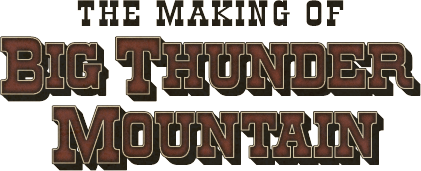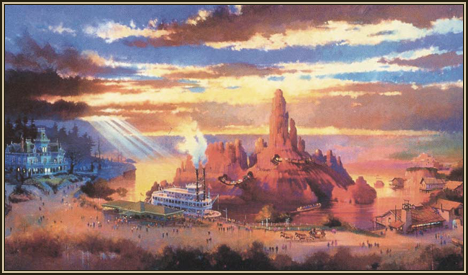
Nº 4 — The Ultimate Thunder
As you’ll have noticed by this point, the Imagineers weren’t content with simply copying the same roller coaster ride and show elements over and over again for each park; they took pride in using their time and budget to improve each new edition of the attraction. As Pat Burke adds, “Each Big Thunder got more research and more artifacts as a result.”
When time came to build a new Magic Kingdom in Europe, the Imagineers collected a binder full of ideas of how they could enhance the existing concepts. Cultural differences would also play heavily into the layout for this new theme park.

Early Euro Disneyland concept map. © Disney.
It was determined that in France, Mark Twain’s stories did not have the same importance as they did in the United States. As a result, Tom Sawyer Island, traditionally in the center of Frontierland, was moved to Adventureland and given a Treasure Island setting. At the same time, the tranquil Frontier town of previous parks made way for an energetic Gold Rush boomtown. These considerations would be instrumental in shaping the new Big Thunder Mountain…
As Jeff Burke, executive designer for this new Frontierland (no relation to Pat), shares, “Considering the European fascination for the Old West, we set the story of Paris Frontierland in the American Southwest of the mid to late 1800s. Then we modified each attraction to support this setting and time frame.”
For the first time, Big Thunder Mountain would be present in opening day plans for Frontierland, which opened up the Imagineers’ possibilities considerably. It was suggested to place Big Thunder Mountain in the — now vacant — center of the Frontierland river. This new setting would make it the dynamic centerpiece of the land. “Big Thunder Mountain, which visually anchors the land with the look of Monument Valley, also represents the excitement and spectacle of the Gold Rush Era,” Jeff Burke explains.

Frontierland concept art by R. Tom Gilleon. © Disney.
When the ambitious idea of placing the roller coaster on an island was discussed, the engineers were taken aback at first, doubting that having underground tunnels for the trains to reach the island would be feasible. True to form, initial doubts were soon put on the side however and the Imagineers began working out the difficulties. As Pat Burke relates, “The underwater tunnels going and coming from the island were a great challenge. We had to deal not just with the river overhead, but a concrete center guide rail that the Mark Twain and Molly Brown riverboats would use as they passed over the tunnel.”

Big Thunder Mountain under construction. Photo courtesy of EuroSouvenirland.
“This tunnel had to be deep enough below the river bottom and yet be able to realign with the load building re-entry track.” As Pat explains, it had to be both safe and practical for a gravity-powered roller coaster. “We had to design the tunnel so that the trains could get enough speed to reach the island and return to the mainland. This tunnel makes Paris’ Big Thunder Mountain the fastest of the four… and is only part of what makes it the best.”
Part of the challenge was to design a building for the trains to re-emerge after their trip to the island. “Tony Baxter was concerned about this building blocking the view of the mountain from the queue and out front of the attraction, so I came up with this unique building with sloped roof from my research buying trips. I tried to photo-document any buildings and architectural mining details I could find, as these would be used in the Euro Disneyland design and field installation. Tony loved the building.”

Load building concept art. © Disney.
The main load building, the attraction’s focal point on the mainland, was also enhanced further from its predecessors. “I did over eleven different queue line designs to accommodate the amount of people operations wanted in line. That gave me a chance to put in a lot of walk-around show elements,” Pat recalls.

| 
